Table of Contents
Overheating Caused by Oil in Coolant: Mercedes-Benz CLA W118 Case Study
Overheating caused by oil in coolant is one of the most critical engine problems a Mercedes-Benz owner can face. Not only does it compromise the cooling system, but it also risks catastrophic engine failure if ignored.
In this case study, we examine a Mercedes-Benz CLA W118 equipped with the M282 engine, brought into the workshop with overheating symptoms and evidence of oil contamination in the coolant. We’ll cover the customer complaint, diagnostic process, root cause analysis, repair steps, and key preventive insights.
This guide provides practical knowledge for Mercedes owners, enthusiasts, and technicians, helping identify, prevent, and resolve this costly issue.
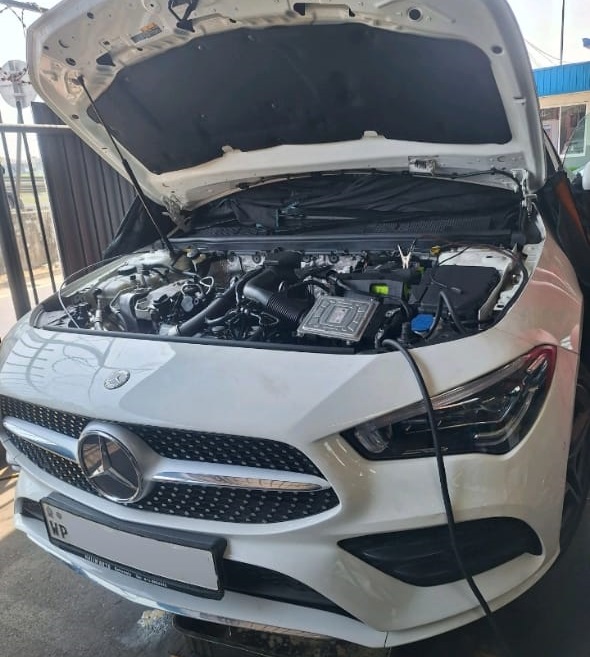
Customer Complaint: Engine Overheating in Mercedes CLA
The owner reported that their CLA W118 overheated after a short drive. Despite the coolant level appearing sufficient, the engine temperature climbed rapidly.
Additional symptoms included:
- – Discolored coolant with a milky, frothy texture.
- – Oil residue visible inside the coolant reservoir.
- – No noticeable coolant puddles under the vehicle.
The contamination clearly pointed toward an internal cooling system failure.
Step-by-Step Diagnosis
1. Understanding the Cooling System
The Mercedes CLA W118 (M282 engine) uses a sophisticated cooling system including:
- – Radiator
- – Thermostat
- – Electric water pump
- – Radiator fan
- – Expansion tank (coolant reservoir)
- – Engine oil cooler
- – Cylinder head gasket
Failures in any of these components can trigger overheating or oil-coolant cross-contamination.
2. Initial Checks
The workshop began with basic inspections:
- – Coolant level: Found near minimum.
- – Coolant quality: Milky and discolored, confirming oil contamination.
- – External leaks: None detected.
- – Cooling fan & thermostat: Both tested and functioning normally.
At this point, the suspicion narrowed to internal leakage.
Root Cause Analysis: What Causes Oil in Coolant?
The two most common causes of oil mixing with coolant in this engine configuration are:
1. Blown Head Gasket
Both components were carefully inspected.
Engine Oil Cooler Test
A pressure test was performed on the oil cooler. Results showed no leakage. This ruled out the cooler as the cause.
Cylinder Head & Gasket Inspection
The cylinder head was removed for detailed inspection. Findings included:
- – Visible cracks in the head gasket.
- – Oil passage breaches into the coolant channels.
- – Slight discoloration in coolant passages, consistent with prolonged mixing.

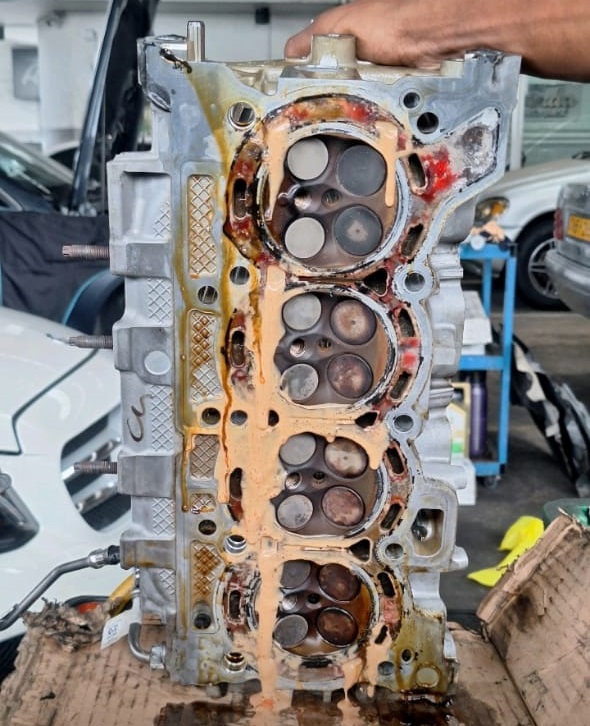

Conclusion: The blown head gasket was the direct cause of oil in coolant and subsequent overheating.
Repair Process & Parts Replaced
The repair required both corrective and preventive measures to restore system integrity.
1. Cylinder Head Gasket Replacement
- – The cylinder head was inspected and resurfaced; no warping was found.
- – Old gasket removed and replaced with a new OEM Mercedes-Benz head gasket.

2. Water Pump Replacement (Preventive)
- – Although still functional, the electric water pump was replaced to ensure long-term circulation reliability.
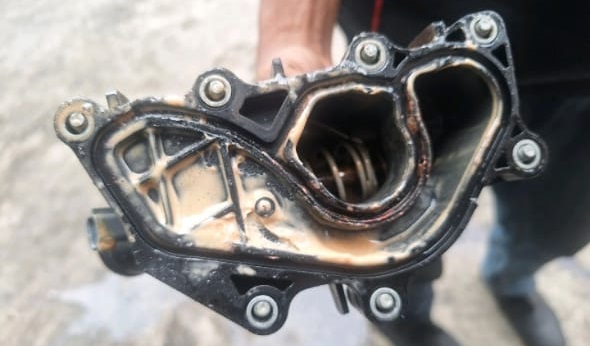
3. Spark Plug Replacement
- – Contamination risks misfires. New spark plugs were installed for clean combustion.
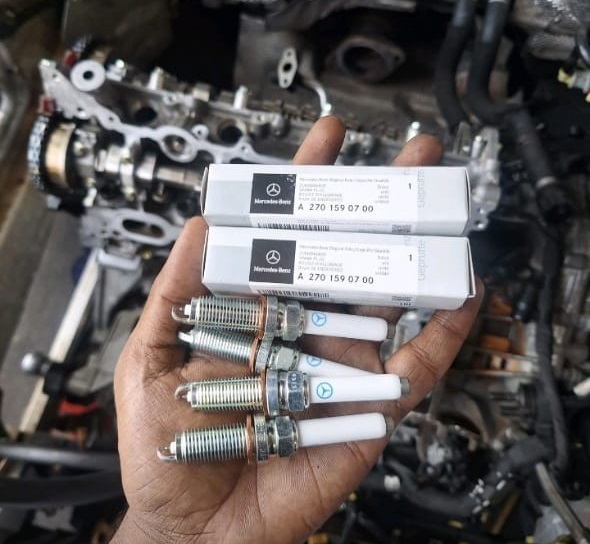
4. Full Cooling System Flush
- – Multiple flushes were performed using a special coolant flush solution to remove oil sludge from radiator, hoses, and heater core.
- – Final refill with Mercedes-approved coolant (MB 325.0 specification).
5. Road Test & Final Verification
- – Engine tested under various loads.
- – Temperatures remained stable.
- – No further signs of oil contamination or overheating.
Why Oil in Coolant Causes Overheating
When engine oil mixes with coolant, the system’s ability to regulate temperature is severely compromised.
- – Oil forms sludge, restricting coolant flow through radiator and water jackets.
- – Heat transfer efficiency drops, leading to higher engine temperatures.
- – Temperature sensors become coated, sending inaccurate readings to the ECU.
- – In turbocharged engines like the M282, cooling demands are higher, making contamination especially dangerous.
If unresolved, this condition can cause warped heads, seized pistons, or total engine failure.
More Mercedes Cooling System Resources
Want to explore more causes, symptoms, and repair tips for coolant leaks, overheating, and contamination?
Learn more about Mercedes cooling system faults in our full Cooling System Guide.
related article:
Why Is Coolant Mixing with Engine Oil? Mercedes Diagnosis Guide
Oil Mixing With Coolant: Case Study & Solution
Coolant Reservoir Boiling And Overflowing: Solution Here
Key Questions Answered
Can oil in coolant cause engine overheating?
Yes. Oil reduces coolant’s heat absorption ability and creates sludge that clogs circulation. In performance engines, this quickly leads to overheating and possible engine damage.
Does oil in coolant always mean a blown head gasket?
Not always. While it’s the most common cause, it can also result from a cracked cylinder head, warped block, or failed oil cooler. In the M282, both the head gasket and oil cooler are common failure points, so both must be tested.
How do you know if your head gasket is blown?
Typical signs include:
- – Oil in coolant (milky appearance).
- – Coolant in engine oil (chocolate milk oil on dipstick).
- – White exhaust smoke from coolant entering combustion chamber.
- – Bubbling in the expansion tank.
- – Persistent overheating.
Definitive confirmation comes from leak-down testing, combustion gas detection in coolant, or physical inspection after head removal.
What are the first signs of a blown head gasket?
- – Unexplained coolant loss.
- – Overheating after short drives.
- – Milky sludge on oil filler cap.
- – White exhaust smoke at startup.
- – Rough idling and reduced performance.
Early detection can save thousands in repairs.
What are the symptoms of oil mixing with coolant?
- – Frothy, discolored coolant in reservoir.
- – Sludge under radiator cap.
- – Overheating or heater not working properly.
- – Cloudy, diluted engine oil on dipstick.
If these symptoms appear, stop driving immediately to prevent severe damage.
Preventive Tips for Mercedes Owners
- – Regular coolant inspections: Check levels and color every month.
- – Use only OEM coolant & gaskets: Prevents corrosion and ensures compatibility.
- – Don’t ignore small leaks: They often precede major failures.
- – Service water pumps & thermostats on schedule: Reduces risk of overheating.
- – Act at first signs of overheating: Even one overheating event can warp heads or damage gaskets.
Final Thoughts
The case of overheating caused by oil in coolant in a Mercedes-Benz CLA W118 (M282 engine) demonstrates the importance of early diagnosis and proper repair.
- – The issue stemmed from a blown head gasket, allowing oil to mix with coolant.
- – By replacing the gasket, flushing the system, and performing preventive repairs, the engine was restored to full health.
- – Ignoring this warning could have resulted in catastrophic failure and a complete engine rebuild.
Key takeaway: If you notice coolant contamination, overheating, or discolored fluid in your Mercedes, seek professional diagnostics immediately. Acting early saves money, prevents breakdowns, and extends the life of your engine.
Author
Written by: Mercedes Expert
Automotive Technical Trainer & Mercedes-Benz Diagnostic Specialist
With years of hands-on experience repairing and diagnosing Mercedes-Benz vehicles, specializes in case-study-based troubleshooting guides that blend workshop accuracy with educational clarity.
Last Updated: August 2025

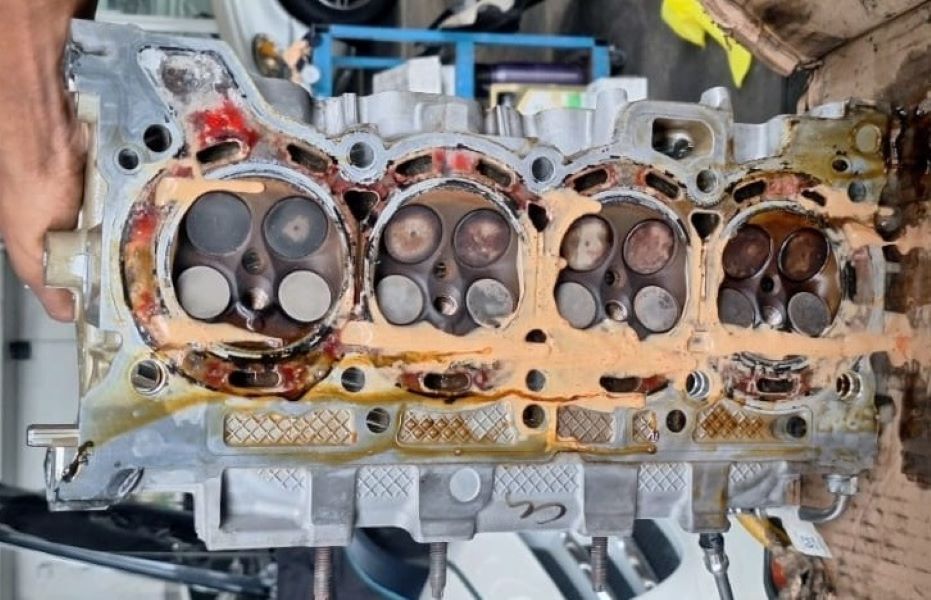


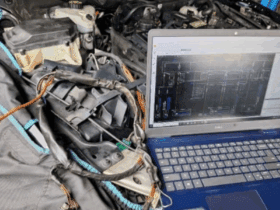
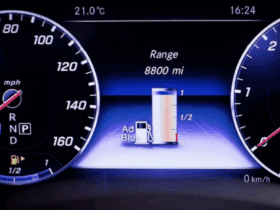
Leave a Reply